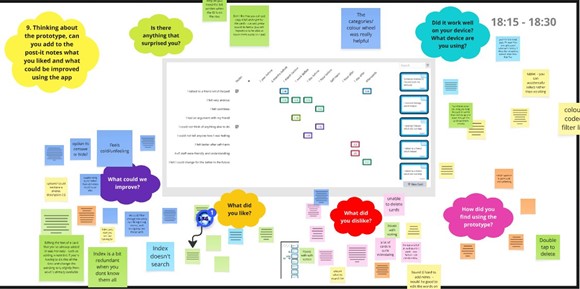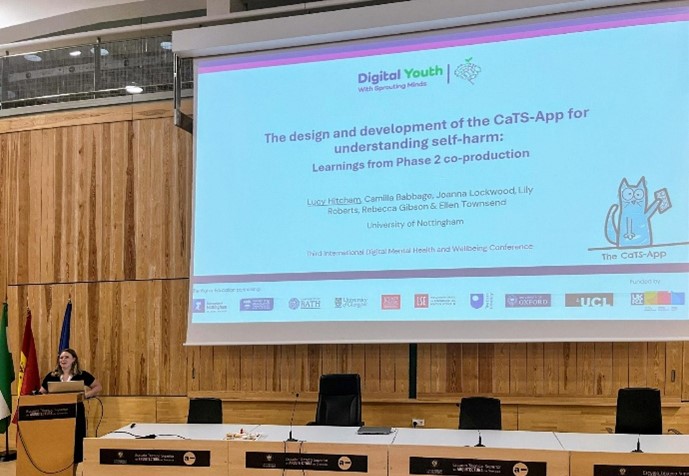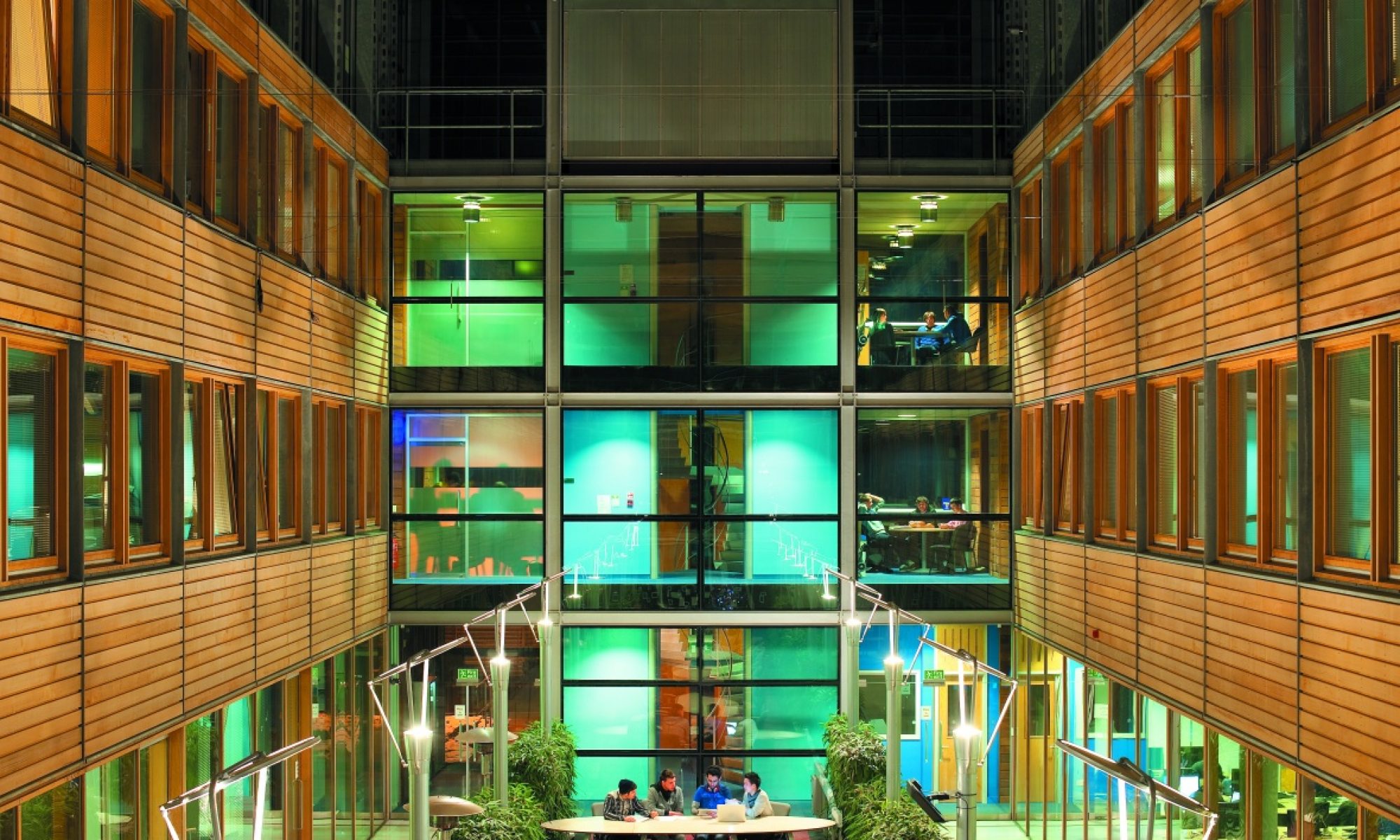post by Lucy Hitcham (2023 cohort)
*Trigger warning: Mentions of self-harm
Technologies have vast potential to improve our mental health and wellbeing and tackle the rising youth mental health crisis. With increasing rates of young people suffering from mental health disorders and engaging in self-harm, the Digital Youth research programme is focused on understanding the complex risks and opportunities for mental health associated with young people’s engagement with the digital world.
In the summer of 2024, I began my part-time research placement with the CaTS-App (Card sort Task for Self-harm) team, one of the ongoing projects of the Digital Youth programme. This project aims to co-develop a new digital tool to understand and support young people who self-harm, building upon prior research into self-harm and suicide in adolescence. With my PhD research focusing on the use and responsible design of digital mental health interventions, I was thrilled to join the team to see the co-development of this technology in action while deepening my understanding of co-design, digital mental health interventions, and interdisciplinary collaboration.
Bringing my experience to the project
For the placement, I helped the team build on their phase 1 findings, which focused on understanding the need and attitudes of stakeholders and initial concept development for this proposed digital version, into phase 2 of their work. Phase 2 was aimed at designing and refining a digital prototype informed by young people’s lived experiences using three co-design workshops and patient and public involvement (PPI) feedback activities.
These workshops were one of the main focuses of my placement: helping to understand the goals and information being sought for this phase and translating them into three workshops for our group of young people. I heavily drew on my interdisciplinary background in childhood studies, psychology, digital mental health and responsible practice to develop workshop activities that were creative, engaging and successfully addressed the questions we wanted to ask, while being sensitive to the young people’s age and lived experience of self-harm.
The result was three carefully crafted Miro boards which were used in the online co-design workshops to gather our groups’ opinions on how the app would be used with professionals, which design features would be appealing and appropriate to complete the CATS tasks, how data protection and security could be addressed, and how we could enhance the user-experience for the digital version of this tool. Following the content analysis of all these responses, we then held a showcase to make sure we correctly represented the young people’s voice before feeding all design decisions back to the app creators in the team to develop the next version of the app prototype.
Throughout this process, I was able to draw on my experience with theory, research methods and knowledge as an interdisciplinary researcher to work with the different team members and implement the intended research goals into practical activities that remained authentically user-centred and ethically grounded in the voices of those it intended to support.

What did I learn?
One of the goals of my PhD is to understand how digital mental health interventions are developed in a responsible way, using practices such as co-design. The placement offered an invaluable opportunity to observe and participate in this process first-hand and understand the benefits co-design offers, but I have some other key takeaways for this placement.
Firstly, I have been able to recognise that creativity plays a valuable role in academic research. Engaging young people through creative co-design activities enabled richer insights than more traditional methods might have produced, particularly in understanding their preferences, motivations, and emotional responses to digital mental health tools. With this, I have developed my technical skills in using Miro to design visual, interactive content which I hope to use more in the future.
The placement also highlighted the importance of starting with end users from the outset. Rather than adapting existing technologies to fit user needs, the approach adopted by the CaTS team ensured that young people’s perspectives shaped the project from the very beginning. Firstly, this means that the digital tool is addressing a need expressed by the community, to be problem-focused and not solution-focused, and secondly, that these valuable insights were continuously brought in to properly address this need for supportive tools for self-harm care. This felt very meaningful to me, and hopefully to the young people involved.
Lastly, I was able to realise the benefits that being an interdisciplinary researcher brings me. I found it incredibly helpful to be able to draw on my knowledge and experience in different disciplines for this placement. And while being an interdisciplinary researcher can feel like an identity crisis at times, it has been valuable to see how it can be a real strength!
Presenting the work
To finish off the placement, I had the opportunity to present at the third International Digital Mental Health and Wellbeing (DMHW) Conference in sunny Granada, Spain in May 2025. This event brought together leading researchers, practitioners, and innovators working at the intersection of technology and mental health, with a particular focus on young people’s wellbeing.
This was a valuable opportunity to present our findings from phase two of the CaTS-App project and hear about other research happening in the field, particularly from my fellow presenters in the co-design session. It was an excellent chance to highlight some of the strengths of the project, including our creative methods, sustained engagement with our young people, along with the additional young people advisory group, Spouting Minds, who are invaluable to the Digital Youth programme.


Concluding Reflections
My placement with the CaTS-App project has been a pivotal experience in my doctoral training. It demonstrated how participatory and interdisciplinary approaches can enrich the design of digital mental health interventions, ensuring they are both evidence-based and responsive to the needs of their end users.
Beyond the methodological insights, the placement has shaped my broader understanding of how research can translate into meaningful, user-centred innovation to support our population’s mental health needs. It reinforced the notion that impactful digital health solutions emerge not solely from academic expertise, but from collaboration, creativity, and a sustained commitment to co-production. I have greatly enjoyed my time with the CaTS team and thank them dearly for including me in this important work!
To learn more about the CaTS-App project, including our research reports and next steps, please visit the project webpage.

